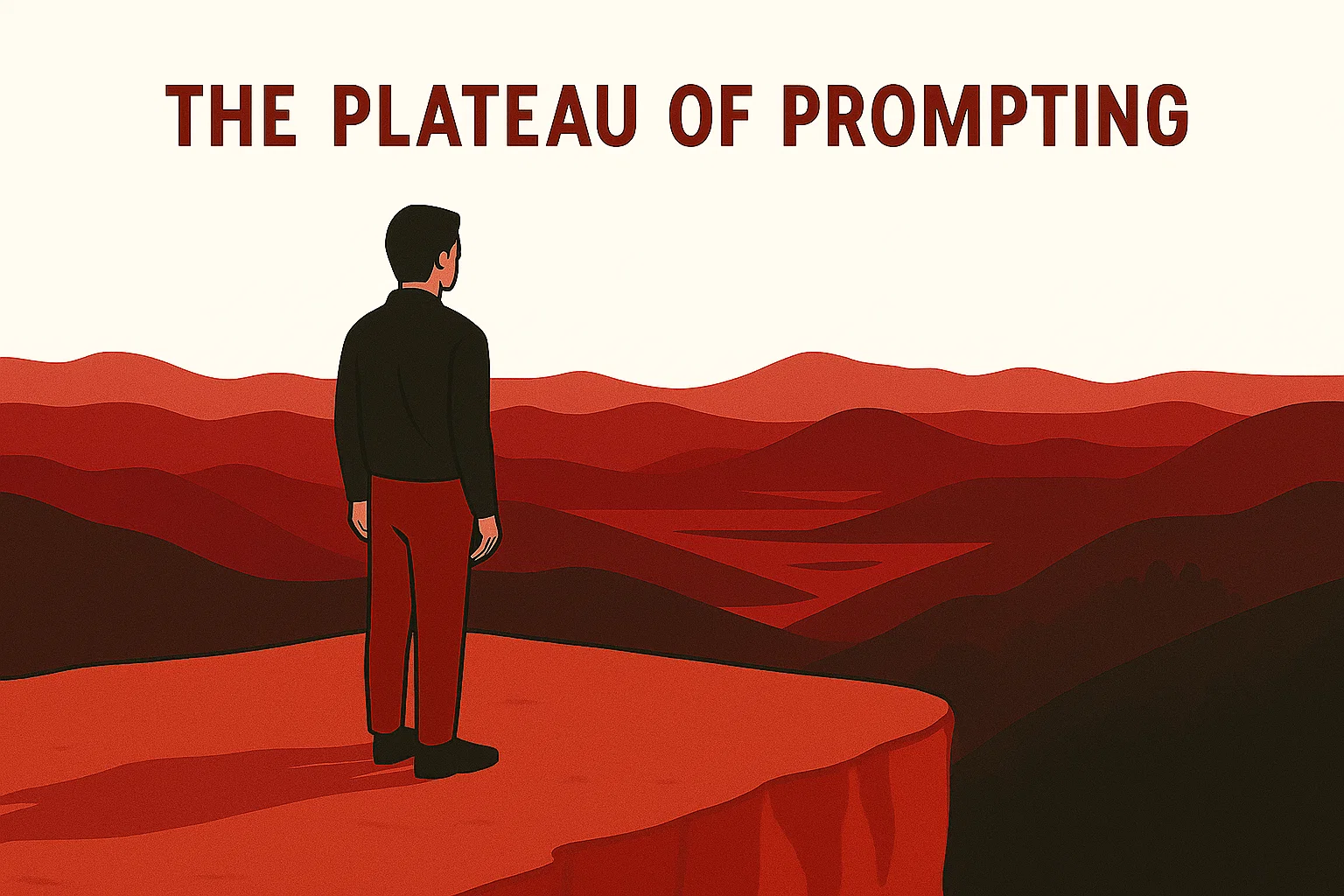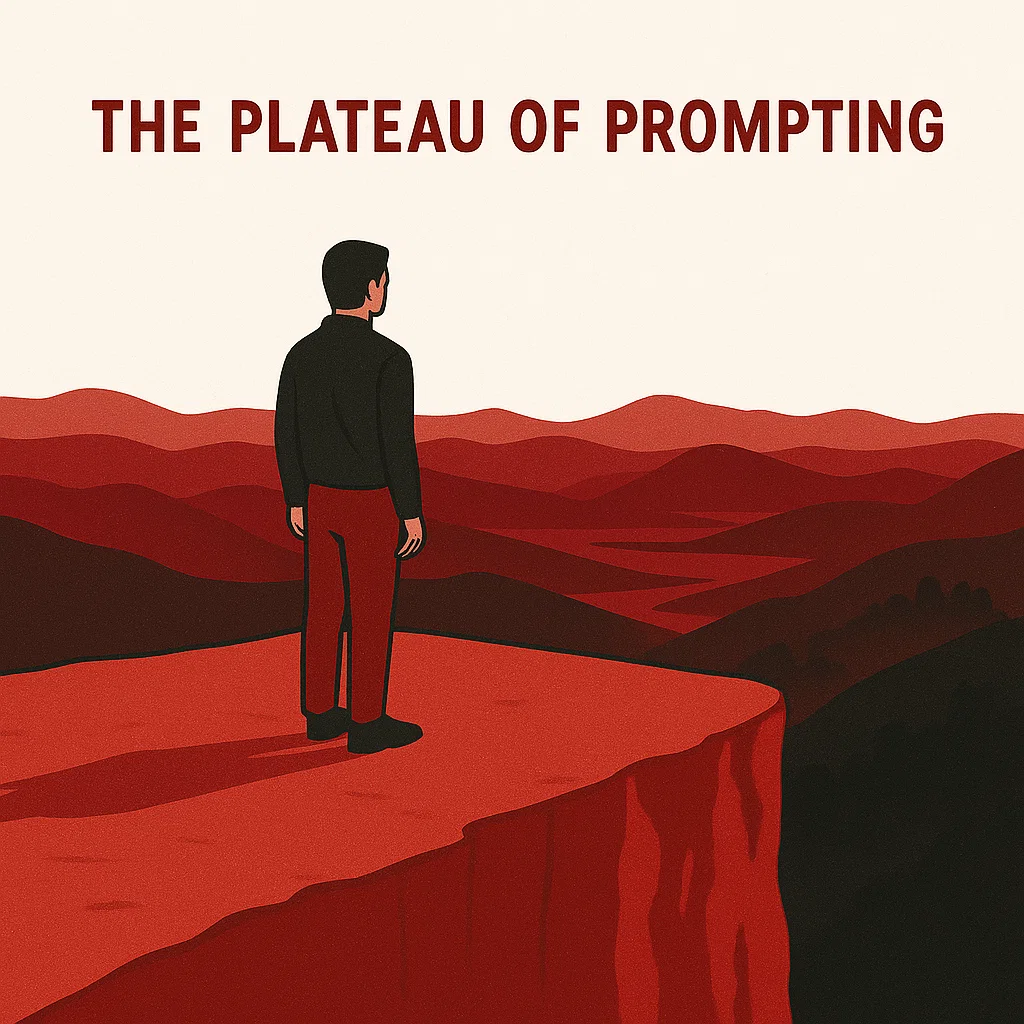The Plateau of Prompting: How to Know When It’s Time to Move Beyond Off-the-Shelf AI

Explore Our Latest Insights
The Plateau of Prompting: How to Know When It’s Time to Move Beyond Off-the-Shelf AI

Let's get straight to it. Your team is probably using off-the-shelf AI tools like ChatGPT. You’ve seen the initial productivity pop. It’s great for drafting emails, summarizing long documents, and brainstorming ideas. But now, you’re starting to feel the friction. The answers are getting a little too generic. You’re spending more time trying to force the tool to understand your business than you’re saving by using it.
If this sounds familiar, you’ve likely hit what we call the "Plateau of Prompts." It’s that point where the one-size-fits-all nature of generic AI starts creating more problems than it solves. Your organization is getting serious about AI, but the tools you started with just can’t keep up. The initial magic has worn off, and you’re left wondering what’s next.
Here’s the deal: recognizing you’re on this plateau is the first step toward building a real, defensible competitive advantage with AI. It’s the signal that you’re ready to graduate from being a casual user to an active architect of intelligent systems that create durable value.
Based on our work on the front lines, we’ve identified five critical signals that show you’ve outgrown generic AI. These aren’t just technical annoyances; they are strategic business challenges that impact everything from efficiency to your competitive standing.
The Performance Plateau
This is the most common sign. The AI just doesn’t “get” your specific business context. You find your team spending hours on “prompt engineering”, trying to craft the perfect set of instructions to coax a useful response out of a generalist model. But as your tasks get more complex, the prompts become brittle and unmanageable, and the returns diminish.
It gets worse. The newest, most powerful models from providers like OpenAI have sophisticated built-in reasoning that can actually be confused by the complex prompting techniques teams developed for older models. You end up in a frustrating loop where trying harder to get a good result only makes things worse. When you reach the point where the bottleneck isn’t how you ask the question, but what information the model has access to, you’ve hit the plateau.
The Data Risk Threshold
The casual use of public AI tools eventually runs into the hard wall of enterprise data security. This signal appears when the data you’re feeding the AI – think customer information, R&D plans, confidential financials – is more valuable than the convenience of the tool.
When you send your proprietary information to a third-party AI, you’re not just risking a leak; you’re handing over your intellectual property. These providers can and do use your data to train their future models, which they then sell to the entire market, including your direct competitors. You are, in effect, paying a vendor to devalue your own proprietary data and commoditize your market intelligence. For any business serious about protecting its IP, this is a non-starter.
The Integration Wall
The AI tool works fine on its own, but it’s an island. It doesn’t connect to your core systems: your custom CRM, your ERP, your production databases. Instead of seamless automation, you get clumsy workarounds.
We see this all the time. A team has to manually copy-paste data from a core application, feed it to the AI, and then paste the result back into another system. This doesn’t just kill productivity; it creates "shadow workflows" and adds to your technical debt. If your AI isn’t deeply integrated and feeding insights back into your core business operations, it’s a gadget, not a transformation engine.
The Scalability Ceiling
The pay-as-you-go API model that was so attractive for your pilot project becomes a financial trap at scale. As your usage grows, the API fees can skyrocket, turning a small experiment into a major operational cost that eats away at your margins.
You also hit technical limits, like API rate-limiting, which caps your request volume and can degrade your user experience right as your product is taking off. The tool that helped you launch your MVP is now actively preventing you from scaling it. You get caught in a vise: scaling usage leads to unsustainable costs, while trying to limit costs hurts performance.
The Competitive Moat Imperative
This is the most important signal from a strategic perspective. You realize that if all your competitors are using the exact same off-the-shelf AI, there’s no sustainable advantage. You can’t build a competitive moat using a commoditized tool that anyone can license for a monthly fee.
True differentiation comes from creating proprietary AI capabilities that are unique to your business. Imagine your customer service chatbot can access real-time inventory and a customer’s purchase history to give specific, helpful answers, while your competitor’s can only give vague responses. That’s not just a feature; it’s a competitive weapon. It’s also a powerful asset that makes your company more attractive to investors and potential acquirers.
Charting Your Course: From Prompting to True Capability
Recognizing these signals is the first step. The next step is to move forward strategically. This isn’t a simple “build vs. buy” debate anymore. For most enterprises, the answer lies in the middle ground between generic tools and building a multi-million-dollar model from scratch.
Here are the three practical pathways:
Retrieval-Augmented Generation (RAG)
For most companies, RAG is the most direct and powerful next step. It directly solves the context problem by connecting a general-purpose AI to your own proprietary knowledge base—your product manuals, support tickets, or internal wikis. When a query comes in, the system first retrieves relevant, factual information from your data and then uses that to augment the prompt to the AI. This dramatically reduces hallucinations, allows for real-time knowledge updates, and provides sourceability so you can trust the answers.
Use RAG when your AI needs to know new, proprietary, or rapidly changing facts.
Fine-Tuning
Fine-tuning is what you do when the goal isn’t to teach the AI what to know, but how to behave. This process adjusts a pre-trained model’s internal parameters to align with a specific style, tone, or structured format. You might fine-tune a model to adopt your company's specific brand voice in marketing copy or to generate code that adheres to your internal standards. It specializes the model for a repeatable skill that’s too nuanced for a simple prompt.
Use fine-tuning when you need to change the model's fundamental behavior, style, or ability to perform a specific task.
Custom Models
Building a model from the ground up is the most resource-intensive path, reserved for when AI is the absolute core of your business and your primary competitive differentiator. This route offers unparalleled control and performance on a specific task but comes with massive costs (millions of dollars), long timelines, and the need for elite, in-house talent. This is for companies aiming to create a core piece of intellectual property that is impossible for competitors to replicate.
A Quick Decision Matrix
To make it simple, here’s how to think about it:
Problem: "My AI gives wrong or outdated answers."
Solution: RAG.
Problem: "My AI needs to sound like my brand."
Solution: Fine-tuning.
Problem: "My data is too sensitive to send to a third party."
Solution: RAG or Fine-Tuning, run in your own private environment.
Problem: "AI is the core of our IP and our primary product."
Solution: A Custom Model.
The leap from off-the-shelf tools is about more than just technology; it’s about a shift in mindset. It’s about building the organizational capacity and leadership to wield these powerful tools effectively. The ROI is clear and measurable. Not just in saved labor hours and reduced costs, but in higher quality work, better decision-making, and superior customer experiences. We're talking about tangible results, like a 25% boost in productivity, a 70% reduction in content creation costs, or a 40% reduction in errors.
The initial phase of AI adoption was about experimentation. The next phase is about building durable, proprietary value. The journey starts when you recognize the limits of generic tools and make the deliberate choice to become an architect of your own intelligent systems. That is how you’ll build a competitive advantage that lasts.




